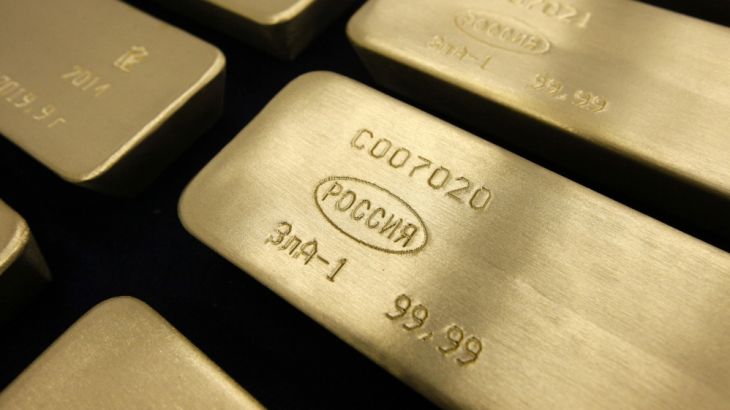
Behind Russia’s gold buying spree
As Moscow buys the yellow metal in record amounts, we ask if gold is a geopolitical financial weapon.
Russia is spending more on gold than at any time since the break-up of the Soviet Union.
Over the past year, Moscow has spent more than $7bn on gold, and now its total gold holdings of 1,208 tonnes are worth $49bn – making Russia the fifth biggest holder of gold in the world. The United States has the most, with almost eight times that amount.
Keep reading
list of 4 itemsEcuador weighs security, international arbitration in latest referendum
‘Triple spending’: Zimbabweans bear cost of changing to new ZiG currency
Boeing hit with 32 whistleblower claims, as dead worker’s case reviewed
At the same time, Russia’s currency reserves have shrunk by more than $100bn as it defends the rouble’s rout. Russia is a nation in recession, its economy is under Western sanctions, and its biggest export, oil, is under pressure.
So could President Vladimir Putin be pushing back through this gold shopping spree?
He has railed against the dominance of the dollar and has dumped some of the country’s holdings of US government debt. It has been termed as a kind of financial weaponisation.
So what is driving Moscow’s gold buying spree? Can Russia back its currency with gold? Is gold a geopolitical financial weapon? Or are sanctions really forcing Putin to dump his foreign currency reserves?
Bill Browder, the founder of Hermitage Capital, at one time the biggest investor in Russia, talks to Counting the Cost.
Ukraine’s economic challenge
Russia’s presence in Ukraine has brought Western sanctions onto Russia, but it has also pushed Ukraine to the brink of bankruptcy, and into an IMF-led $40bn bailout.
Paul Brennan brings two reports explaining the scale of Ukraine’s economic challenge.
Bangladesh’s organ traffickers
In Bangladesh, the trade in human organs is big business. Each year, hundreds of people put their body parts up for sale in an underground organ bazaar.
Potato farming is the primary source of income in this area but it is not a big earner. Farmers say they earn about $200 from a three-month harvest, and that barely covers their costs, so many are tempted by the promises of organ traffickers.
Al Jazeera’s Maher Sattar brings more on this story.
The fight against wildlife poaching
South Africa has been forced to sell some of its wildlife. It has moved around 100 rhinos to neighbouring countries and into private reserves just to protect them from poachers.
The illegal wildlife trade is estimated to be worth around $150bn a year, according to the United Nations Environment Programme.
Rhino horn is more valuable than gold and platinum, with a kilo of rhino horn worth $65,000. It is popular in Asia where it is used in some medicines.
Over the border in Zimbabwe, there is a similar situation. Endangered elephants are being rounded up to be sold overseas. Zimbabwe has had money problems for years – leaving its national parks deprived of cash. So selling the elephants could provide the Zimbabwe Parks and Wildlife Authority with much needed resources to pay for roads and water.
Nepal is actually a good case study of a country that has had success in tackling the poaching problem. Al Jazeera’s Subina Shrestha brings a report from Kathmandu.
So what is driving the illegal wildlife poaching in South Africa and what can be done to tackle it?
Pelham Jones, the chairman of the Private Rhino Owners Association in South Africa, talks to Counting the Cost.